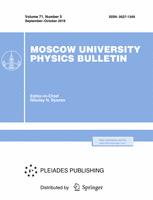The compositions $Ga_{2/3}Cr_2S_4, Cu_{1/2}Me_{1/2}Cr_2Se_4$ ($Me=In, Ga$), $Cu_{2/3}Ge_{1/3}Cr_2S_4$, and solid solutions of the type $xCuCr_2S_4—(1—x)Ga_{2/3}Cr_2S_4$ ($0<x<0,4$) and $xCuCr_2Se_4—(1—x)Cu_{0,5}Me_{0,5}Cr_2Se_4$ ($Me = In, Ga$; $0<x<0,1$) are shown to possess magnetic properties that are typical of spin glasses. These features include (i) a maximum in the initial susceptibility (at a definite temperature $Т_f’$, (ii) the dependence of low-temperature magnetic properties of a sample on its thermomagnetic prehistory and on time, and (iii) the lack of spontaneous magnetization (as established by the Belov-GoryagaArrott method). There are several experimental facts suggesting the existence of a spin glass-paramagnetic phase transition: (i) the validity of several static and dynamic scaling relationships and of the Almeida-Thouless condition and (ii) the presence of a giant maximum of negative magnetoresistance.
Department of General Physics for Natural Science Faculties, Faculty of Physics, Moscow State University, Leninskie Gory, Moscow, 119992, Russia



